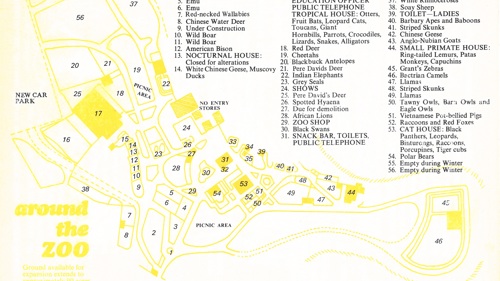Glasgow Zoo - Times Past

In partnership with the Glasgow Times, our archivists are exploring Glasgow's fascinating history. This week, Nerys Tunnicliffe writes about Glasgow Zoo.
Glasgow Zoo, also known as Calderpark Zoo, was established by the Zoological Society of Glasgow, opening on 9th July 1947. Initially many of its animals were donated from other zoos, including two lions from London Zoo, and exotic pets from private donors. At its peak it attracted 140,000 visitors annually, owned 600 animals and employed over 24 staff members.
The zoo wasn’t the first-time wild animals had been exhibited in Glasgow. Amongst the examples are George Wombwell’s touring menagerie established in 1805, which included elephants, lions, a rhinoceros and zebras, which visited the city many times becoming a regular feature at Glasgow Green during the fair holiday. The short-lived Glasgow Zoological Gardens on old estate lands at Cranstonhill was set up by Thomas Atkins in 1840 with wild goats and alpacas. Atkins ran similar Zoological Gardens in Liverpool. Edward H Bostock, whose great uncle had been George Wombwell, opened The Scottish Zoo and Variety Circus on New City Road in 1897, famed for its ‘performing’ lions and tigers, amongst elephants, hyaenas and more. At Oswald Street, near Central Station, Wilson’s Zoo opened in 1936 and ran till the 1950s. Operated by the Wilson family who previously owned a zoo in the railway arches in Argyle Street, visitors could see monkeys, parrots, a black panther, a badger and more.
However, most of the city’s previous ‘zoos’ were more akin to circuses, intended primarily for entertainment and spectacle rather than for any conservation or educational reasons. The Zoological Society of Glasgow placed an emphasis on conservation and learning, with captive breeding projects and close links with local schools through visits.
The Zoological Society of Glasgow was founded in 1936, with Edward Hindle, Professor of Zoology, University of Glasgow as its president. The society’s mission from the start was to establish zoological gardens, originally as part of the 1938 Empire Exhibition at Bellahouston Park. However, their proposal was rejected by the exhibition organisers, and after consideration the site of the lands of the former Calderpark estate were purchased by the society (renaming themselves the The Zoological Society of Glasgow and West Coast of Scotland, due to the site being just outside of the Glasgow’s boundaries). The estate’s old mansion house was already demolished, and the wooded, parkland setting made it an ideal location. Despite a delay caused by the outbreak of the second world war, and a scarcity of building materials, the zoo was originally a success. In the 1950’s there was even a dedicated train station serving the zoo.
Glasgow Zoo focused on birds, reptiles, mammals and farmland animals with white rhinoceros, African lions, Asian black bears, and a polar bear (named Winston), alongside peacocks, lorikeets, and a golden eagle. Reptiles included boa constrictors, pythons and tortoises. Farm animals included ponies, pigs, sheep, goats, and geese.
An education officer was employed in 1973 to run the society’s education service, and a magazine ‘Zoolife’ with articles about the zoo’s animals was issued from 1970 to 1984. Members of the society were given discounted admission charges and received free copies ‘Zoolife’.
Unfortunately, the latter years of the zoo were marred by financial difficulties with reported £3.5 million debts. Falling visitor numbers and the lack of public funding led to the poor upkeep of facilities which in turn led to growing concerns over animal welfare at Calderpark. The shocking theft of two snakes, and a few months later a parrot, from the zoo in 2002 added to the zoo’s woes. In 2003 the zoo, which had delighted children and local families decades before, was closed with the SSPCA assisting in relocating animals.
